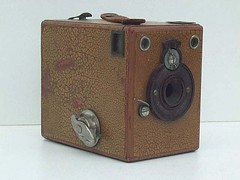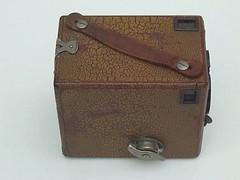Sakura (box)
See also the Sakura bakelite camera in 4×5cm format, also made by Konishiroku; for other uses, see the "Sakura" disambiguation page.
The Sakura (さくら) is a wooden box camera made from 1931 by Konishiroku (predecessor of Konica). It exists in two sizes. The model taking 4×6.5cm pictures on 127 film was released first and it was followed by a model taking 6×9cm pictures on 120 film.[1]
Description
The Sakura is an ordinary box camera, with brilliant finders for vertical and horizontal pictures. The lens is fixed-focus, and the name SAKURA CAMERA is inscribed below, together with the model size 4×6½cm or 6×9cm.
The shutter has T and I settings selected by a small arrow above the lens. It is said that this shutter was the first made by Konishiroku itself, while previous Konishiroku cameras were equipped with imported shutters.[2]
There is a handle, embossed SAKURA and diagonally attached to the top of the camera. The back is hinged to the bottom; the back latch is at the top and is engraved ROKUOH-SHA TOKYO. The interior of the camera consists of a metal frame, grouping the exposure chamber, film rollers, spool holders and even the lens. This frame comes out as a whole for film loading.
 
|
  
|
| Sakura box, 4×6.5, brown. image by Ferry Knemeijer (Image rights) |
Versions
The Sakura 4×6.5 exists in three versions, all with rectangular finder eyepieces and a single uncovered red window in the middle of the back. Some sources say that the camera was supplied with a mask allowing to take 3×4cm pictures as well.[3] The 127 roll film sold in Japan at the time maybe had indications on the paper backing for half-frame pictures.
The first version has a black finish, and a sliding release lever on the right-hand side.[4] The second version has a crinkled brown finish with brown fittings, and a pivoting release lever attached to the front plate.[5] The third version is similar but has a knurled advance knob instead of the advance key.[6]
The Sakura 6×9 has always been observed in brown finish, and three versions are known. All are dual format, taking both 6×9cm and 4.5×6cm exposures. There are small prongs in the eyepieces to indicate the field of view for half frame exposures. The back has three red windows, grouped under a vertical metal plate on the right. There is a metal sliding cover which can take two positions, differentiated by the number 1 and 2 showing under a small frame attached to the sliding part. In position 1, the top red window is opened for 6×9 exposures; in position 2, the two other red windows are opened for 4.5×6 exposures. The numbers 1 and 2 probably mean "full frame" (one picture per frame) and "half frame" (two pictures per frame).
The evolution of the large model parallel that of the smaller one. The first version[7] has rectangular eyepieces and the shutter release on the right hand side, at the bottom. No aperture control is visible. The second version[8] has round eyepieces, a pivoting shutter release on the front plate, and an index at the bottom of the lens, with three positions marked A, B and C, used to set the aperture.[9] The third version is similar but has a knurled advance knob instead of the advance key, the same as on the 4×6.5 model.[10]
Commercial life
The sources agree that the Sakura was released in 1931.[11] It was an inexpensive camera at the time it was sold: the 4×6.5 version cost ¥3.50 and the 6×9 cost ¥5.[12]
Original box
The original cardboard box has a greenish colour with red patterns and a naive drawing of schoolboys playing sports, photographed by a young boy and a young man, supposedly using Sakura box cameras.[13] The markings are SAKURA CAMERA in the Roman alphabet, and ラメカらくさ ("Sakura camera" from right to left in a mix of hiragana and katakana script), an indication of the format, an inscription inviting to use Sakura film, and finally the maker's name 社櫻六 ("Rokuoh-sha" from right to left, in old writing) and 京東 ("Tokyo" from right to left).
Notes
- ↑ Order of the models: Nihon no kamera, pp.26–7.
- ↑ See this page of the Camera Information Center (archived).
- ↑ Tanaka, p.37 of Kurashikku Kamera Senka no.10. Sugiyama, item 4014, mentions dual format, perhaps by mistake.
- ↑ This version is pictured in Sugiyama, item 4013, and in this page of the Center of the History of Japanese Industrial Technology.
- ↑ This version is pictured in Sugiyama, item 4014. One example observed for sale by a dealer has a small silver metal strip for the "T" and "I" indications, certainly to replace the broken brown plastic part.
- ↑ This version is pictured in Tanaka, p.37 of Kurashikku Kamera Senka no.10.
- ↑ This version is pictured in this page at Pacific Rim Camera, in Tanaka, p.37 of Kurashikku Kamera Senka no.10, and in Lewis, p.43.
- ↑ This version is pictured in this page of the Center of the History of Japanese Industrial Technology.
- ↑ A, B, C indications: Sugiyama, item 4015.
- ↑ This version is pictured in Sugiyama, item 4015.
- ↑ Tanaka, p.37 of Kurashikku Kamera Senka no.10; Kokusan kamera no rekishi, p.12; Lewis, p.43; Sugiyama, items 4013–5.
- ↑ Nihon no kamera, p.27; Tanaka, p.37 of Kurashikku Kamera Senka no.10.
- ↑ Original box pictured in this page at Pacific Rim Camera.
Bibliography
- Asahi Camera (アサヒカメラ) editorial staff. Shōwa 10–40nen kōkoku ni miru kokusan kamera no rekishi (昭和10–40年広告にみる国産カメラの歴史, Japanese camera history as seen in advertisements, 1935–1965). Tokyo: Asahi Shinbunsha, 1994. ISBN 4-02-330312-7. P.12.
- Baird, John R. The Japanese Camera. Yakima, WA: Historical Camera Publications, 1990. ISBN 1-879561-02-6. P.27 (picture only).
- Christies auction catalogue: "Fine and Rare Cameras", 5 November 1992, lot 348. (The description of the Sakura 6×9cm camera mentions "three film format adjustment", certainly because of the three red windows.)
- Christies auction catalogue: "Cameras and Optical Toys", 13 January 1994, lot 208.
- The Japanese Historical Camera. 日本の歴史的カメラ (Nihon no rekishiteki kamera). 2nd ed. Tokyo: JCII Camera Museum, 2004. P.16.
- Lewis, Gordon, ed. The History of the Japanese Camera. Rochester, N.Y.: George Eastman House, International Museum of Photography & Film, 1991. ISBN 0-935398-17-1 (paper), 0-935398-16-3 (hard). P.43.
- Nihon no kamera – Tanjō kara konnichi made (日本のカメラ・誕生から今日まで, Japanese cameras, from the birth to the present day). Tokyo: Nihon Kamera Hakubutsukan (日本カメラ博物館, Japan Camera Museum), 1989. (Exhibition catalogue, no ISBN number)
- Sugiyama, Kōichi (杉山浩一); Naoi, Hiroaki (直井浩明); Bullock, John R. The Collector's Guide to Japanese Cameras. 国産カメラ図鑑 (Kokusan kamera zukan). Tokyo: Asahi Sonorama, 1985. ISBN 4-257-03187-5. Items 4013–5. (See also the colour pictures at the beginning.)
- Tanaka Masao (田中政雄). "Konica history 4. Taishō 12-nen – Shōwa 8-nen." (Konica history 4. 大正12年–昭和8年. From Taishō year 12 (1923) to Shōwa year 8 (1933).) Kamera Rebyū: Kurashikku Kamera Senka (カメラレビュー クラシックカメラ専科) / Camera Review: All about Historical Cameras no.10, September 1987. No ISBN number. Konishiroku kamera no rekishi (小西六カメラの歴史, special issue on Konishiroku). Pp.33–8.
Links
In English:
- Brown Sakura 6×9 with original box in the Pacific Rim Photographica Pages
In Japanese:
- Black Sakura 4×6.5 and brown Sakura 6×9 in the Camera database of the Center of the History of Japanese Industrial Technology
- Pages of the R. Konishi Rokuoh-sha website:
- Brown Sakura 4×6.5 and bakelite Sakura 4×5
- Camera list with the Sakura box
- Drawing on the user manual (reproduced in small size)
- Konica history at the Camera Information Center website (archived)
In Korean:
- Brown Sakura 6×9 at Infocam (archived)
| Konishiroku prewar and wartime cameras () | ||||||
|---|---|---|---|---|---|---|
| plate | hand cameras | stereo hand cameras | strut folders | box | telephoto | SLR |
| Idea (original) | Idea A | Idea B | Idea Snap | Idea No.1 | Idea (metal) | Lily (original) | Lily (horizontal) | Lily (metal) | Tropical Lily | Noble | Ohca | Sakura Palace | Sakura Pocket Prano | Sakura Prano | Idea Binocular | Sakura Binocular Prano | Minimum Idea | Idea Spring | Korok | Champion | Cherry | Sakura Army | Sakura Honor | Sakura Navy | Idea Telephoto | Idea Reflex (1910 and 1911) | Idea Reflex (1932) | Neat Reflex | Sakura Reflex Prano | |
| rollfilm | folders | box or collapsible | TLR | |||
| Pearlette | Special Pearlette | B Pearlette | Pearl (for plates and rollfilm) | Pearl No.2 | Pearl (Year 8) | Baby Pearl | Semi Pearl | Sakura Palace | Record | Sakura (box) | Sakura (bakelite) | Sakura-flex | ||||